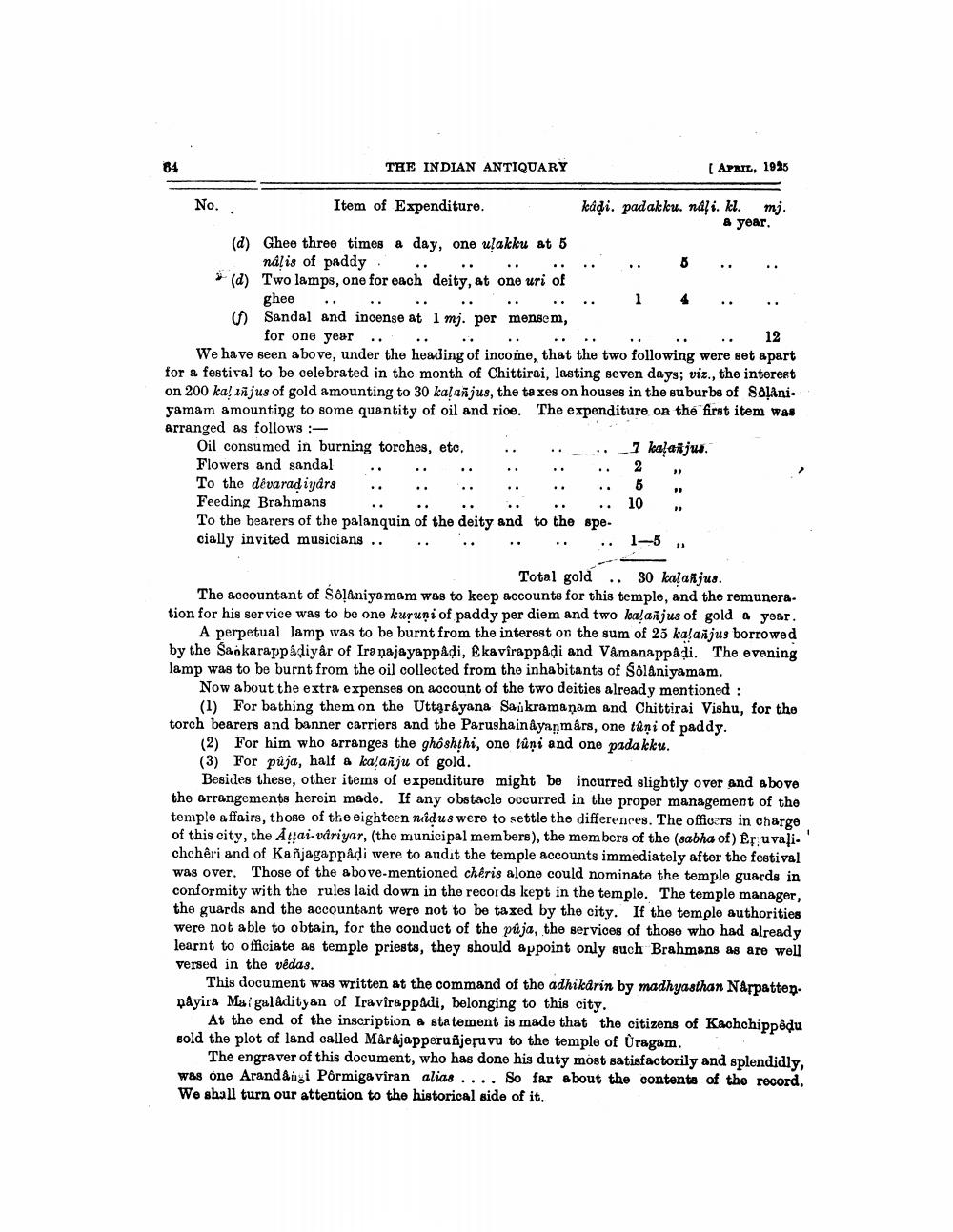________________
THE INDIAN ANTIQUARY
APRIL, 1925
No. Item of Expenditure.
kaði. padakku. nați. kl. mj.
& year. (d) Ghee three times a day, one ulakku at 5
nális of paddy .. (d) Two lamps, one for each deity, at one uri of
ghee .. .. .. .. .. .. . 1 4 .. .. o Sandal and incense at 1 mj. per mensem, for one year .. ..
.. .. 12 We have seen above, under the heading of income, that the two following were set apart for a festival to be celebrated in the month of Chittirai, lasting seven days; viz., the interest on 200 ka! 17jus of gold amounting to 30 kalanjus, the taxes on houses in the suburbs of soļani. yamam amounting to some quontity of oil and rice. The expenditure on the first item was arranged as follows:
Oil consumed in burning torches, etc. .. .. .. 7 kalanjua. Flowers and sandal .. .. .. .. .. .. 2 To the devarad iydr3 . . . . . . . . . . . .
- Feeding Brahmans
.. .. 10 To the bearers of the palanquin of the deity and to the spe. cially invited musicians .. .. .. .. .. .. 15
Total gold .. 30 kalaijus. The accountant of Solaniyamam was to keep accounts for this temple, and the remuneration for his service was to be one kuruni of paddy per diem and two kalanjus of gold a year
A perpetual lamp was to be burnt from the interest on the sum of 25 kalanjus borrowed by the Sankarappadiyâr of Ira najayappadi, Ekavirappadi and Vamanappadi. The evening lamp was to be burnt from the oil collected from the inhabitants of Solaniyamam.
Now about the extra expenses on account of the two deities already mentioned :
(1) For bathing them on the Uttarayana Sajkramanam and Chittirai Vishu, for the torch bearers and banner carriers and the Parushain ayanmars, one tani of paddy.
(2) For him who arranges the ghoshthi, one túni and one pada kku. (3) For pûja, half a kalanju of gold.
Besides these, other items of expenditure might be incurred slightly over and above the arrangements herein mado. If any obstacle occurred in the proper management of the temple affairs, those of the eighteen niidus were to settle the differences. The officers in charge of this city, the Auai-váriyar, (the municipal members), the members of the (sabha of) Eruvaļi. chchêri and of Kañjagappadi were to audit the temple accounts immediately after the festival was over. Those of the above-mentioned chéris alone could nominate the temple guards in conformity with the rules laid down in the records kept in the temple. The temple manager, the guards and the accountant were not to be taxed by the city. If the temple authorities were not able to obtain, for the conduct of the puja, the services of those who had already learnt to officiate as temple priests, they should appoint only such Brahmans as are well versed in the vēdas.
This document was written at the command of the adhikarin by madhyasthan Narpatten. payira Ma i galádityan of Iravirappadi, belonging to this city.
At the end of the inscription a statement is made that the citizens of Kachchippêdu sold the plot of land called Marajapperunjeruvu to the temple of Uragam.
The engra ver of this document, who has done his duty most satisfactorily and splendidly, was one Arand&igi Pôrmiga viran alias .... So far about the contents of the record, We shall turn our attention to the historical side of it.




